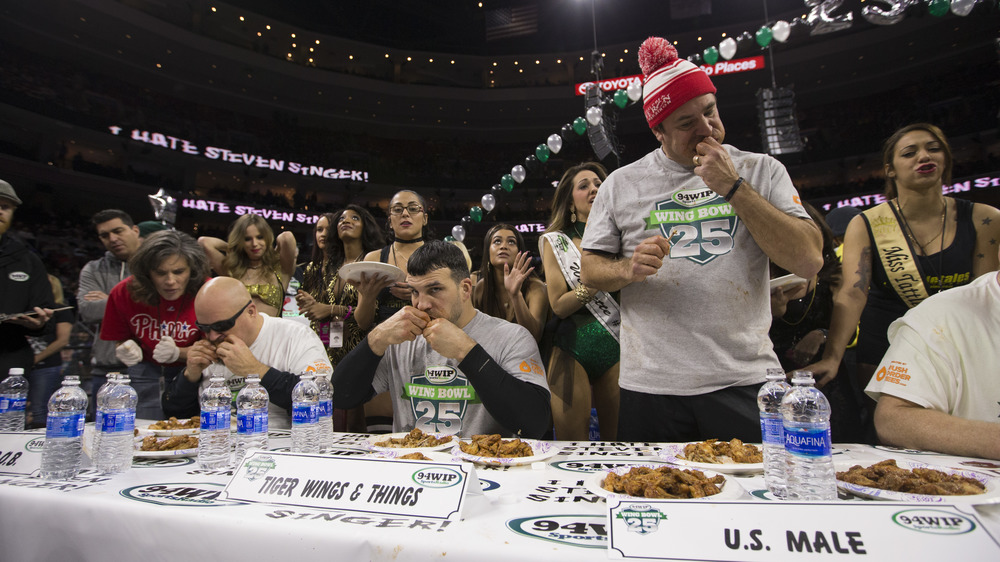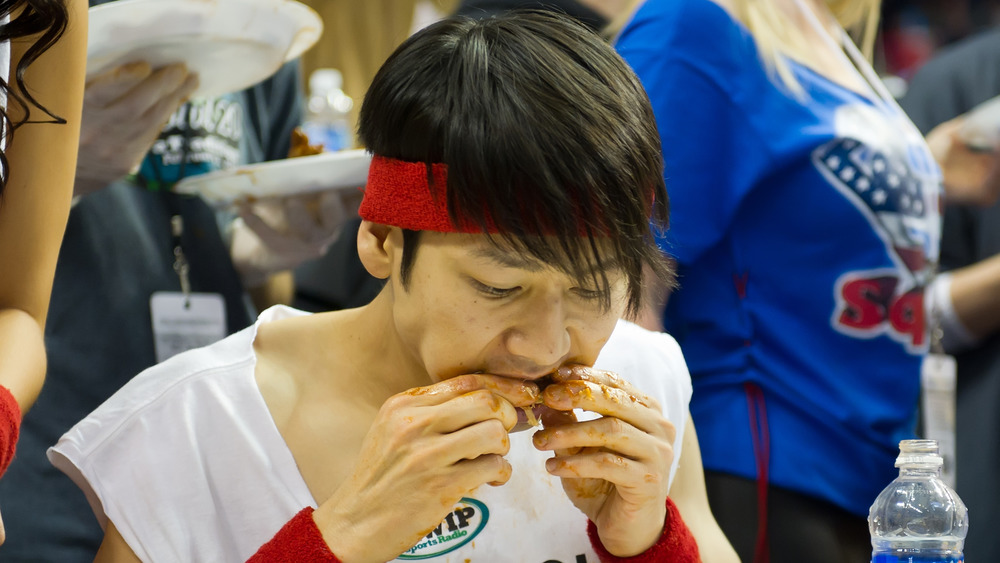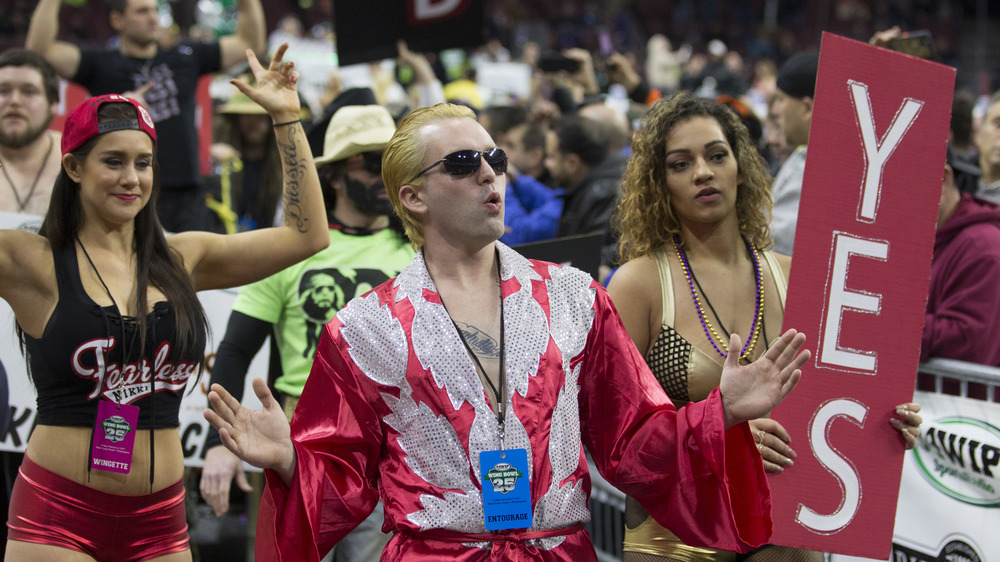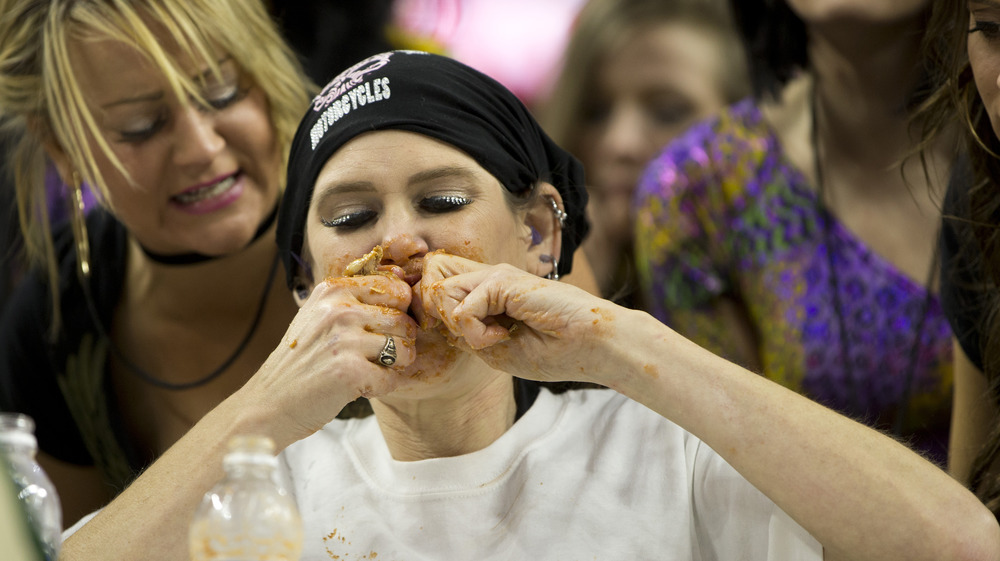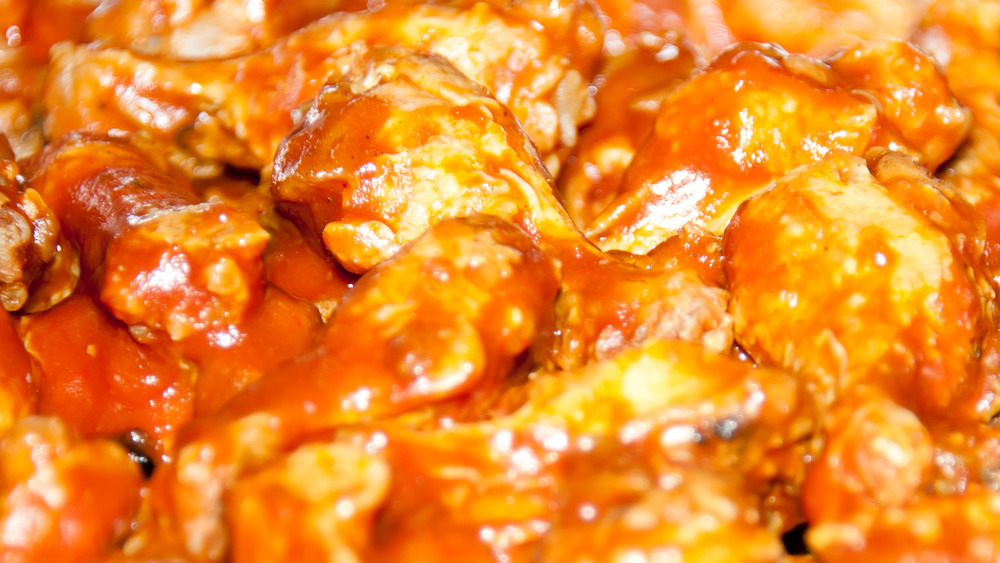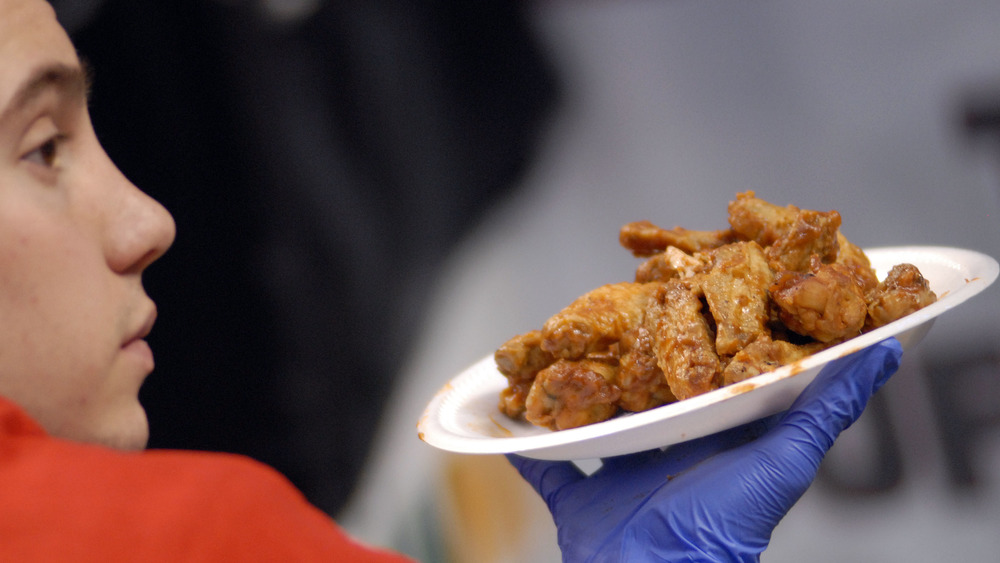The Untold Truth Of The Philadelphia Wing Bowl
In October 2018, Angelo Cataldi and the Morning Crew announced that the Philadelphia Wing Bowl held in February of that year would be the last of its kind. As PhillyVoice explained while conveying the news, the annual Buffalo wing eating competition, which took place on the Friday before the Super Bowl, began in 1993 as an attempt to mitigate the local fans' feelings of disappointment over the Eagles' inability to make it to the final match.
Now, however, it was different. "This was the right time to go out and if there was a time to stop doing, after winning the Super Bowl was the time," Spike Eskin, Entercom Philadelphia's program director, explained in an announcement kept on an under-utilized memorial site for the event.
Reactions to the news were mixed. Many lamented the end of a quarter-century tradition, while others, like investigative journalist Julie K. Brown, took to Twitter to laud its end. "Good move Philly & WIP. Time for Philly fans to start acting like the Super Bowl champions we are — not the deplorable fans the rest of the country thinks we are."
The Philadelphia Wing Bowl was a true eating competition
While the reputation the Philadelphia Wing Bowl gained during its tenure was one of debauched insanity, the actual competition drew in proper contenders. Part of this was due to the qualifications needed to surround yourself with drunk fans as you hoover chicken wings. In 2017, CBS Philly listed six methods aspiring competitors may use to compete in the 2018 Wing Bowl, including completing or submitting to eating challenges on air during the Morning Show, as well as winning at other competitions.
These requirements ensured that anyone from the street can compete while also drawing stars. In 2012, as CBS reported, competitive eater Takeru Kobayashi won $20,000 for consuming 337 chicken wings over the course of half an hour before a crowd of 20,000 people in the Wells Fargo Center, a massive arena that also houses the Philadelphia Flyers and 76ers. The Philadelphia Inquirer also noted that this smashing victory was met with boos from the audience. Tony Luke Jr., cheesesteak-maven, stated that it was probably because "people are just shocked that a local guy didn't win."
A similar reception met Joey Chestnut's dominance a few years previous. Talking with Philadelphia's local CBS, Chestnut described bottles hurled at him for being an opponent to the locals. "It was just anarchy," he revealed. "It was debauchery." He hurried to add that at other Philly-based eating events, he met more supportive fans, saying that the Wing Bowl just brought the worst to the forefront.
The Wing Bowl bowled over many with its sheer hedonism
The succinctness of Chestnut's description of "anarchy" and "debauchery" barely outlines what the Philadelphia Wing Bowl was like. "They sell more beer at that event than any other at the arena. It's amazing," he continued. "These guys from age 17 to 65 just obliterated, yelling at you to eat wings and it's a weird feeling."
Additionally, Reuters discussed the Wingettes contest, in which women arrived on floats while baring their bodies in a provocative manner while encouraging women spectators to do the same for cameras, which projected bared chests on the screens surrounding.
Writer Jim Caple deemed it "the worst event ever" in an article for ESPN. "It's like what you would get if you mixed the Olympics opening ceremonies with Mardi Gras and spring break and crammed it all inside a hockey rink," he explained. "Except in place of each country's national anthem, throw in video of projectile vomiting from a past contest."
Accusations of sexism, delinquency, and every other negative epithet concerning Philadelphia's worst aspects tend to be used when talking about the Wing Bowl. However, while admitting all the negatives stated or implied, spectator Charlie Warzel confessed in a 2015 BuzzFeed piece that, "what the Wing Bowl, at its best, preserves, is its very real, very raw humanity, which eschews any and all attempts at elitism and classism."
It has seen the world record for wings eaten
In the final Philadelphia Wing Bowl in 2018, competitive eater Molly Schuyler won by eating 501 wings in 30 minutes. This, as CBS News pointed out during their coverage, broke her previous record from 2015 of 440 wings. More importantly, however, it broke the world record of wings eaten in a contest. Interestingly enough, the final Philadelphia Wing Bowl wasn't the only time that a wing eating world record was set; when Schuyler set her best at 440 chicken wings, she actually lost the competition to Patrick "Deep Dish" Bertoletti's 444 wings, according to Spoon University.
Wondering how Schuyler managed to reach these heights without dying from severe indigestion, Inverse ran a piece on how her diminutive 105-pound body, in fact, gave her a huge edge over the bigger eaters — who you would imagine would dominate these competitions. The edge is due to the fact that since Schuyler has less abdominal fat, her stomach can expand more. Another move she perfected was keeping the track from her mouth to her stomach straight so that she can consume more food more quickly.
While the Philadelphia Wing Bowl may lack the relative class of Major League competitive eating, the feat Schuyler pulled off outstrips the record on the League's website, which still has Joey Chestnut's 182 wings in 30 minutes as the bar to beat.
Preparing the wings was a huge operation
Consider that the record set by Schuyler was over 500 wings for one person in 30 minutes at the Philadelphia Wing Bowl. Then consider the fact that there was the main competition, a first responders competition, and other categories. Then consider the fact that there are multiple rounds — that's a lot of chicken wings.
In their reporting on the Philadelphia Wing Bowl behind-the-scenes, Thrillist estimates that almost 10,000 wings are prepared for the competition. Without resorting to frozen wings, 10 fryers in New Jersey begin around midnight to cook all 10,000 wings for eight minutes. Then, they're loaded into hot boxes and transported to the stadium at a temperature regulated between 135 and 140 degrees, to keep the food fresh but also intact. Before being brought out, the wings also have to be sauced — naturally — before being tossed back into the hot boxes. The whole process demands strict timing, but after two decades the team behind the competition got the routine down pat.
You can still eat the wings that provided the entertainment
The Philadelphia Wing Bowl is no longer an annual event. But you can still eat the wings that were served at the raucous competition.
In 2019, The Philadelphia Inquirer listed P. J. Whelihan's as a location to get your wings for the Super Bowl. With 19 locations in South Jersey and Pennsylvania, P. J. Whelihan's is a pub and restaurant chain that, of course, offers wings and ten different types of sauces and other pub fare like burgers and nachos.
As you might expect considering the experience they have with catering for large orders, P.J. Whelihan's also boasts a crowd-pleaser menu that offers, among other deals, 50 wings for $55. Moreover, they deliver, and as they have a proven capability for providing hot wings on delivery, they would make a good bet for any wing needs you may have — the last relic of a controversial institution.
